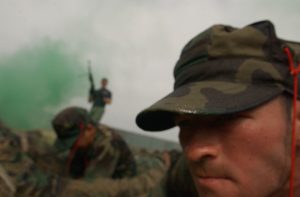
Basic Underwater Demolition/SEAL (BUD/S) training is the ultimate test of physical and mental endurance. It is the gateway to becoming a Navy SEAL, one of the most elite special operations forces in the world. This grueling program pushes candidates to their limits and beyond, forging them into warriors ready for any challenge.
The journey to attend BUD/S begins long before a candidate arrives in California. Prospective operators must first go through a warfare preparatory program. The Naval Special Warfare Preparatory School gives candidates the foundational fitness and skills needed to survive the main course.
BUD/S training itself takes place at the Naval Special Warfare Center in Coronado, California. The program lasts about 24 weeks and is divided into three distinct phases. Each phase of this demolition/SEAL training presents its own set of challenges for aspiring SEALs to overcome.
What Is Basic Underwater Demolition SEAL Training Table of Contents:
- First Phase: Basic Conditioning
- Second Phase: Diving
- Third Phase: Land Warfare
- What Sets BUD/S Training Apart
- Physical Demands of BUD/S
- Mental Toughness in BUD/S
- After BUD/S
- Conclusion
First Phase: Basic Conditioning
The first phase of BUD/S, also known as Basic Conditioning, lasts for seven weeks. This initial phase focuses intensely on physical conditioning, water competency, and developing mental toughness. A BUD/S class will see its numbers drop significantly during these first weeks of physical training.
Candidates start their days before sunrise with punishing physical training sessions that include constant swimming running. They face a timed obstacle course, four-mile timed runs in boots, and endless calisthenics. This phase is about building a foundation of strength and endurance that will be tested repeatedly.
During this phase, trainees also learn the fundamentals of hydrographic reconnaissance and small boat operations. They are introduced to small boat seamanship using their Inflatable Boat Small (IBS). The infamous “surf passage” drills introduce candidates to the cold Pacific Ocean waters they’ll become intimately familiar with, a process often called “surf torture.”
Hell Week
The most notorious part of the First Phase is Hell Week. This grueling five-and-a-half-day period occurs during the third week of training. SEAL candidates are pushed to their physical and mental breaking points with almost non-stop activity, receiving less than four hours of sleep total for the entire week.
Activities during Hell Week are an extension of the continuous training they have already faced, but amplified to an extreme degree. This hour crucible involves constant running, swimming in cold ocean waters, and maneuvering their small boat. The purpose is to simulate the stress of combat and weed out those who lack the deep internal drive to become Navy SEALs.
The instructors look for individuals who can perform under extreme duress, remain focused, and work with their team when exhausted and hypothermic. Many candidates who voluntarily drop out of training do so during Hell Week. For many, it’s the toughest challenge they will ever face.
Second Phase: Diving
The second phase of BUD/S lasts seven weeks and centers on combat diving. This phase transitions the training from the beach to underwater. Candidates learn the fundamentals of both basic and advanced SCUBA techniques, becoming proficient combat swimmers.
They are trained in underwater navigation, long-distance underwater dives, and critical combat diving skills. This phase includes learning to use both open-circuit (SCUBA) and closed-circuit compressed air systems. A key piece of equipment is the Draeger LAR V rebreather, a scuba closed-circuit device that doesn’t emit bubbles, allowing for clandestine underwater operations.
The focus is on developing comfort and competence underwater, which is central to the SEAL mission. Candidates learn advanced diving techniques and how to avoid detection while performing tasks. These skills are foundational for the underwater demolition aspect of their future jobs.
Pool Competency
A significant portion of the second phase takes place in the pool, where instructors can safely push candidates to their limits. Candidates must demonstrate their ability to perform various underwater tasks and solve complex problems while holding their breath. These drills, such as knot-tying and equipment assembly, build confidence and reduce panic responses in the water.
Ocean dives are a critical part of this phase as well. Trainees learn to execute scuba long-distance underwater navigation in limited visibility conditions. They also learn how to conduct hydrographic surveys of potential beach landing sites, a core skill for any naval special warfare operator.
Third Phase: Land Warfare
The final phase of BUD/S training is Land Warfare, which lasts seven weeks. This part of the curriculum takes place at San Clemente Island, a rugged and remote training area off the coast of Southern California. Here, candidates learn small-unit tactics, land navigation, patrolling, rappelling techniques, marksmanship, and the safe handling of military explosives.
During this phase, trainees apply their skills in realistic training scenarios with training weapons before moving to live fire. They conduct simulated combat missions and learn to operate effectively as part of a small unit, the core component of a SEAL platoon. The emphasis is on teamwork, communication, and leadership under pressure.
Instructors teach advanced tactics, patrolling techniques, and fieldcraft. Candidates learn how to plan and execute missions, from initial insertion to objective and extraction. This phase solidifies the “Land” portion of the SEAL (Sea, Air, and Land) acronym.
Rock Portage
One of the most physically demanding events in the Third Phase is Rock Portage. Candidates must carry their heavy inflatable boat and all their gear over the island’s sharp, jagged volcanic rocks. This evolution tests both raw physical strength and the mental fortitude to push through pain and exhaustion as a team.
It’s a practical test of a team’s ability to move their equipment over difficult terrain. It reinforces the idea that every member of a small unit must carry their weight. Failure to work together results in a much harder and longer evolution for everyone involved.
What Sets BUD/S Training Apart
What sets BUD/S basic underwater demolition/seal training apart from other military programs is its comprehensive and demanding nature. The program forges well-rounded operators who can function in any environment, whether it’s the sea, air, or land. The training has a deep foundation in SEAL history, which is built upon decades of combat experience.
The training stresses both individual performance and teamwork. Candidates learn to push themselves to their absolute limits while also supporting their teammates. This balance is critical for success in the high-stakes world of special operations.
The ‘First Time, Every Time’ Standard
BUD/S instructors demand an exceptionally high level of performance from all SEAL candidates. The ‘First Time, Every Time’ standard means that tasks must be completed correctly on the first attempt, from tying a knot to clearing a room. This high standard prepares future SEALs for real-world missions where a single mistake can have dire consequences.
This mentality is drilled into candidates throughout every evolution. It builds muscle memory and an automaticity of action that is essential in a firefight or other high-stress situations. There is no room for error when lives are on the line.
Physical Demands of BUD/S
The physical demands of basic underwater demolition SEAL training are extreme. Before they can even attend BUD/S, candidates must be in peak physical condition just to have a chance at completing the program. Daily physical training sessions include long runs in the sand, swim sessions in the ocean, and countless push-ups, pull-ups, and sit-ups.
Cold water immersion is a constant companion throughout BUD/S. Candidates spend hours in the cold Pacific Ocean, learning to function effectively despite the debilitating discomfort. This process builds both immense physical resilience and mental toughness.
The PST
Before a sailor can be considered for a BUD/S contract, they must pass the rigorous Physical Screening Test (PST). This initial physical screening is a good indicator of a candidate’s potential for success. The screening test includes a 500-yard swim, push-ups, curl-ups, pull-ups, and a 1.5-mile run, all with specific time and repetition requirements.
While there are minimum standards, competitive candidates far exceed them. Excelling at the PST shows the dedication and physical aptitude necessary for naval special warfare. Below is a look at the minimum and competitive scores.
| Exercise | Minimum Standard | Competitive Score |
|---|---|---|
| 500-yard swim (sidestroke/breaststroke) | 12:30 | Under 9:00 |
| Push-ups (in 2 minutes) | 50 | 80-100+ |
| Curl-ups (in 2 minutes) | 50 | 80-100+ |
| Pull-ups (no time limit) | 10 | 15-20+ |
| 1.5-mile run (in boots and pants) | 10:30 | Under 9:30 |
Mental Toughness in BUD/S
While the physical challenges of BUD/S are formidable, many graduates argue that the mental challenges are even tougher. Candidates must learn to push through extreme pain, fatigue, and self-doubt. They are constantly under pressure, with instructors observing them for any sign of weakness or hesitation.
Sleep deprivation is a constant factor throughout SEAL BUD/S training, especially during Hell Week. Candidates learn to function effectively and make critical decisions on minimal rest. This is a skill that will serve them well in their future careers as Navy SEALs during extended special operations.
The Bell
One of the most iconic symbols of BUD/S is the brass bell that hangs in the center of the training compound. Any candidate who decides to quit can ring the bell three times, signaling the end of their dream to become a Navy SEAL. The bell is a constant temptation, testing a candidate’s resolve day in and day out.
After BUD/S
Completing basic underwater demolition/seal training is a monumental achievement, but it is not the end of the journey. After BUD/S, graduates are not yet Navy SEALs. They move on to additional training, beginning with SEAL Qualification Training (SQT).
SQT is a 26-week course where BUD/S graduates learn advanced skills in areas like advanced weaponry, communications, and small unit tactics. After successfully completing SQT, these operators finally receive their coveted SEAL Trident. They are then assigned to a SEAL team to begin their operational careers.
Upon arrival at a SEAL team, the new operators will continue to train and develop their skills under the guidance of experienced teammates and senior enlisted leaders. The learning never stops in the naval special community. Continuous training is a way of life to stay at the peak of readiness.
Conclusion
Basic underwater demolition SEAL training is one of the most difficult military training programs on the planet. The underwater demolition/seal training pipeline is constructed to push candidates to their absolute limits, both physically and mentally. Those who make it through emerge as some of the most capable warriors in the world, ready for any mission.
The journey to become a Navy SEAL is long and arduous, starting long before a candidate sets foot in Coronado and continuing throughout their career in the SEAL teams. BUD/S is the crucible that forges these elite operators. It is the beginning of a lifelong commitment to excellence, service, and the quiet professionalism of Naval Special Warfare.
Want more military info? Find your nearest military recruiter here!
